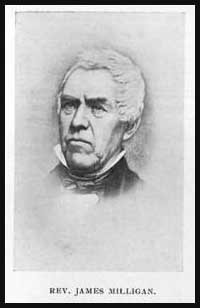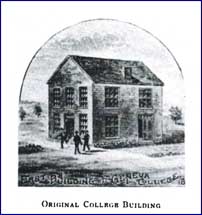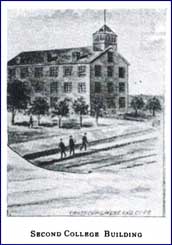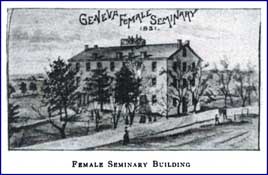 James Milligan, a son of John and Margaret Milligan, was born in Dalmellington, Ayrshire, Scotland, August 7, 1785. His early tendencies were decidedly religious and, at the age of fourteen, he was a communicant in the Established Church. At sixteen he migrated to America, on account of being dissatisfied with the Government of his native country. He made his way to Westmoreland County, Pa., where he had a half-brother settled, and he became a partner with him in a mercantile establishment. Though he had belonged to the National Church in Scotland, he was led now, as the result of diligent inquiry, to cast in his lot with the Covenanters; and, by the advice of Dr. Black, and some others in whom he was disposed to confide, he determined to abandon his secular employment, and, if possible, obtain a liberal education. He, accordingly, entered Jefferson College; but his funds were very quickly exhausted, in consequence of which he went to Greensburg, and opened a school there, which he taught with good success for eighteen months, lie then resumed his place in College, joining the same class he had left, and graduating in 1809 with the first honour. On leaving College he went to Philadelphia, and placed himself, as a theological student, under the care of the Rev. Dr. Samuel B Wylie, and, at the same time, was a Teacher of Languages in the University of Pennsylvania. He was licensed to preach by the Northern Presbytery in 1811 and was ordained Pastor of Coldenham Congregation, Orange County, N. Y., by the same Presbytery, in 1812. During his residence here he performed much missionary labour in the State of New York, and organized many congregations which have since become large and influential. In 1818 he resigned his charge, and was installed Pastor of the Scotch Covenanter Congregation in Ryegate, Vt. Here he continued labouring with great diligence, and encountering many hardships, for nearly a quarter of a century. During this period he laboured throughout the whole region, and made many tours into Canada to visit poor Covenanters scattered through the Provinces. He was intensely Anti-slavery in his views, and was always ready to show his faith by his works. He was translated from Ryegate to New Alexandria, Pa., in 1819; thence to Eden, Illinois in 1848; and, in 1855, he demitted his pastoral charge, and, from that time till the close of life, resided with his sons in Pennsylvania and Michigan. He died at the house of his son, in Southfield, near Detroit, Mich., on the 2d of January, 1862, aged about 77. In 1821, he was married to Mary, daughter of Robert Trumbull, a soldier of the Revolution. They had six children,—five sons and one daughter. Three of the sons are in the ministry of the Reformed Presbyterian Church, and the daughter was married to a minister of the same communion. He was honoured with the degree of Doctor of Divinity ; but when or by what College I am unable to ascertain. He published a Defence of Infant Baptism, in a volume of three hundred pages; A Narrative of the Secession Controversy in Vermont; and a Sermon on Grace and Free Agency, and another on the Prospects of a True Christian in a Sinful World. He was a man of decided ability, intense industry and extensive usefulness.
James Milligan, a son of John and Margaret Milligan, was born in Dalmellington, Ayrshire, Scotland, August 7, 1785. His early tendencies were decidedly religious and, at the age of fourteen, he was a communicant in the Established Church. At sixteen he migrated to America, on account of being dissatisfied with the Government of his native country. He made his way to Westmoreland County, Pa., where he had a half-brother settled, and he became a partner with him in a mercantile establishment. Though he had belonged to the National Church in Scotland, he was led now, as the result of diligent inquiry, to cast in his lot with the Covenanters; and, by the advice of Dr. Black, and some others in whom he was disposed to confide, he determined to abandon his secular employment, and, if possible, obtain a liberal education. He, accordingly, entered Jefferson College; but his funds were very quickly exhausted, in consequence of which he went to Greensburg, and opened a school there, which he taught with good success for eighteen months, lie then resumed his place in College, joining the same class he had left, and graduating in 1809 with the first honour. On leaving College he went to Philadelphia, and placed himself, as a theological student, under the care of the Rev. Dr. Samuel B Wylie, and, at the same time, was a Teacher of Languages in the University of Pennsylvania. He was licensed to preach by the Northern Presbytery in 1811 and was ordained Pastor of Coldenham Congregation, Orange County, N. Y., by the same Presbytery, in 1812. During his residence here he performed much missionary labour in the State of New York, and organized many congregations which have since become large and influential. In 1818 he resigned his charge, and was installed Pastor of the Scotch Covenanter Congregation in Ryegate, Vt. Here he continued labouring with great diligence, and encountering many hardships, for nearly a quarter of a century. During this period he laboured throughout the whole region, and made many tours into Canada to visit poor Covenanters scattered through the Provinces. He was intensely Anti-slavery in his views, and was always ready to show his faith by his works. He was translated from Ryegate to New Alexandria, Pa., in 1819; thence to Eden, Illinois in 1848; and, in 1855, he demitted his pastoral charge, and, from that time till the close of life, resided with his sons in Pennsylvania and Michigan. He died at the house of his son, in Southfield, near Detroit, Mich., on the 2d of January, 1862, aged about 77. In 1821, he was married to Mary, daughter of Robert Trumbull, a soldier of the Revolution. They had six children,—five sons and one daughter. Three of the sons are in the ministry of the Reformed Presbyterian Church, and the daughter was married to a minister of the same communion. He was honoured with the degree of Doctor of Divinity ; but when or by what College I am unable to ascertain. He published a Defence of Infant Baptism, in a volume of three hundred pages; A Narrative of the Secession Controversy in Vermont; and a Sermon on Grace and Free Agency, and another on the Prospects of a True Christian in a Sinful World. He was a man of decided ability, intense industry and extensive usefulness.
Southfield Reformed Presbyterian Church History
The first known organized congregation of the Reformed Presbyterian Church in America (known as the Covenanter’s) was that of Middle Octorara, Lancaster County, Pennsylvania in 1738. In Scotland (where the denomination originated), Reformed Presbyterians had been a separate denomination since the late 1600s. The Reformed Presbytery of the United States of North American was constituted in its current form in 1798, in Philadelphia, Pennsylvania.
By 1834 there were a sufficient number of Covenanters in Southfield to organize a church. Previous to this, the people had gathered together in a prayer society organized by an early landowner, David Stewart, who came to Southfield in the fall of 1831 from White Lake, Orange County, NY. David Stewart worked tirelessly to form a church and, through his influence, other Covenanters such as the McClellands, Browns, McKinneys, Lowes, McClungs, Erwins, and Harmons came from New York to settle in Southfield. In the early years before the church was established the prayer society met for services in barns and vacant log homes belonging to society members such as John Parks and Anthony McClung.
In 1838, a building in which to worship was constructed on an acre of land donated by John Parks at a site on Evergreen Road, just south of Eleven Mile. In 1861, with the need for a larger and more permanent worship facility, the current church building was constructed. In the 1950s a basement was dug and the building was moved back from Evergreen Road onto its new foundation. The congregation continues to worship in this historic structure today. A parsonage was built north of the cemetery in the late 1940s.
In the years leading up to the Civil War, religious and secular leaders increasingly questioned the institution of slavery. One of the earliest religious organizations that took a direct and firm anti-slavery position on the matter of slavery was the Reformed Presbyterian Church. The Church, without exception, was unified on its disposition regarding slavery, and believed all men were created equal in the eyes of God. By the early 1800s, the Covenanters required all members of the church to free their enslaved African Americans.
During this critical period leading up to the Civil War (1853 to 1871) the Rev. J. S. T. Milligan served as the pastor of the Southfield Reformed Presbyterian Church. J.S.T. Milligan was the son of The Rev. James Milligan, D.D. of Vermont who was described as a radical abolitionist. The Milligan family, along with members of the church in Ryegate, Vermont, helped to create the Church’s foundation to help support the anti-slavery and Underground Railroad movements. Clergy and members of the Church became members of anti-slavery societies, UGRR agents, conductors, and station operators. They sheltered and escorted fugitives to freedom from various locations in America to Canada. The Rev. J.S.T. Milligan and probably other members of the Southfield Reformed Presbyterian Church were active participants in the Underground Railroad network in Michigan.
2009 marked the 175th year of the Southfield Reformed Presbyterian Church as an organized congregation.
https://southfieldundergroundrailroad.wordpress.com/biography-jst-milligan/
Biography of J.S.T. Milligan
James Saurin Turretin Milligan
 The Reverend James Saurin Turretin Milligan, 2nd Pastor of the Reformed Presbyterian Church in Southfield, Michigan was born in Ryegate, Vermont on August 25, 1826. He was the second son of James Milligan, D.D., a minister in the Reformed Presbyterian (Covenanter’s) church, a lifelong abolitionist, and an associate of William Lloyd Garrison.
The Reverend James Saurin Turretin Milligan, 2nd Pastor of the Reformed Presbyterian Church in Southfield, Michigan was born in Ryegate, Vermont on August 25, 1826. He was the second son of James Milligan, D.D., a minister in the Reformed Presbyterian (Covenanter’s) church, a lifelong abolitionist, and an associate of William Lloyd Garrison.
J.S.T. Milligan was installed as the pastor of the Reformed Presbyterian Church in Southfield, Michigan on November 11, 1853 where he remained until April 11, 1871.
In a letter dated Dec. 5, 1895 to Professor Wilbur H. Siebert, an Underground Railroad historian, Milligan describes how he and the members of his congregation had always sheltered escaped slaves at their homes and farms. The fugitives came primarily from Kentucky, Tennessee, Missouri, singly or in groups on their way to freedom in Canada. Occasionally former slaves would return to live temporarily with the Milligan family in Southfield when they needed work.
“It was not only difficult to support a family in those days, but it was equally difficult to pay the preacher.” (Edgar) Many early ministers supplemented their income by farming. In “The Covenanter Church of Southfield and Its Early History related by Miss Mary E. Thompson” the author reports that the Rev. J. S. T. Milligan owned a farm at the northwest corner of 11 Mile and Evergreen, where the Birney School is now located. Plat maps of 1864 indicate that the Milligan farm was in that square mile, but located closer to 12 Mile and Evergreen.
“Although the pastor’s salary for 1858 amounted to only $350, there was still great difficulty in raising that sum. One year, after paying all expenses, the [Southfield church] treasurer reported a balance of $0.37. But that was after one of the better years for there were times when the congregation failed to meet its salary payment.” (Edgar)
In 1871, J.S.T. Milligan went to North Cedar (now Denison), Kansas and established a church, many from Southfield going with him. He was installed as pastor of the congregation of North Cedar, Jackson County, Kansas, on October 8, 1872.
The Rev. J.S.T. Milligan and his wife, Jane Thomson Johnson had 9 children, 8 of whom were born and reared in Southfield. They, too, accompanied their parents to Kansas. Milligan spent his time in Kansas until he retired. J.S.T Milligan died August 12, 1912 in Pittsburgh, PA. He was buried in Denison, Kansas.
Resource List
- Thompson, Mary. “The Covenanter Church of Southfield and Its Early History related by Miss Mary E. Thompson.” Birmingham Eccentric. [nd], 1915. [np] <www.reformed.com/history(thompson).php>.
- Edgar, John O. Southfield Reformed Presbyterian Church from 1834-1973. Paper presented at the annual Congregational meeting, Jan. 1972. <http://www.reformed.com/history(edgar).php>.




